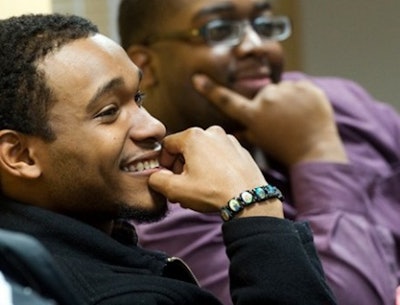 Students of all races are made to feel welcome at the University of North Carolina at Greensboro. (photo courtesy of UNC-G)
Students of all races are made to feel welcome at the University of North Carolina at Greensboro. (photo courtesy of UNC-G)Newly-released analysis of U.S. Education Department data shows that from 2009 to 2011, the rate at which Black and Latino students entered four-year colleges and universities considerably outpaced that of Whites, while six-year graduation rates for underrepresented minority students increased only slightly, according to the Washington-based Education Trust organization.
In the organization’s “Intentionally Successful: Improving Minority Student College Graduation Rates” brief, Education Trust officials described the findings as “encouraging news for those concerned about closing access and success gaps” in American higher education.
Between 2009 and 2011, the nation’s Black undergraduate population jumped by 8.5 percent and Latino undergraduates rose 22 percent, while White college enrollment increased only 2.7 percent. During that same time period, graduation rates also increased. Six-year graduation rates for Latino, White and Black students increased by 4.7 percent, 2.1 percent and 2 percent, respectively.
“The reporting stems from our College Results Online website, and the impetus for this [particular] report was that we completely updated the site to include the most recent information available from the U.S. Department of Education,” said Joseph Yeado, higher education research and policy analyst at The Education Trust and brief author.
Yeado noted that the update to the Education Trust’s College Results Online website includes a comprehensive analysis of almost every individual four-year college and university in the U.S. as measured against peer institutions. The analyses document major differences among colleges serving similar students and showcase effective efforts at schools that have boosted graduation rates for students of color and reduced gaps between Black and Latino students and their White peers.
“We at the Education Trust have focused on equity gaps. So gaps in graduation rates between White and underrepresented students have been something that’s been part of our research agenda,” Yeado said.
“We want those gaps to close,” he added. “We want to provide research that raises this as an issue and, at the same time, work with colleges and universities to find ways to close those gaps for good.”
Michael Dannenberg, director of higher education and education finance policy at the Education Trust, noted that the brief’s graduation rate data brings much-needed attention to the variation among colleges and universities in how their underrepresented minorities fare. “What individual colleges do often can make all the difference in the world between a student graduating or leaving with a pile of debt and no degree. Demography is not destiny, and what colleges do matters,” he said in a statement.
The Education Trust brief spotlights individual schools that are leading and lagging in closing the college completion gap. Among schools cited as leaders, the University of North Carolina at Greensboro saw graduation rates for Black students jump from 52.3 percent in 2010 to 60.1 percent in 2011. Since 2002, UNC-Greensboro has graduated Black students at comparable or higher rates than White students.
UNC-Greensboro officials credit the university’s efforts to cultivate inclusivity and a broad range of student support programs with enabling Black students to do well at the school.
“UNCG has a welcoming and inclusive spirit,” said Dr. Steve Roberson, UNCG’s dean of undergraduate studies. “That, to me, is really the only explanation that seems plausible. That atmosphere is self-authored by this university and by the communities themselves. It’s a grassroots explanation.”
School officials noted that the university programs that help students based on economic disadvantage serve a large cross-section of minority students by default. For example, the UNCG Guarantee program, which has been funded by an anonymous $6 million gift, has benefitted economically disadvantaged students, enabling them to graduate debt-free. In addition, school officials cite the campus’ federally-funded TRIO program as a model for other TRIO programs, which serve economically disadvantaged, first-generation college students or disabled.
At Stony Brook University, Latino graduation rates increased from 58.1 percent in 2010 to 66.5 percent in 2011. The Long Island, N.Y.-based Stony Brook has seen major gains for all of its students over the past nine years, especially Latino students, who now graduate at a slightly higher rate than Whites, according to the Education Trust brief.





















